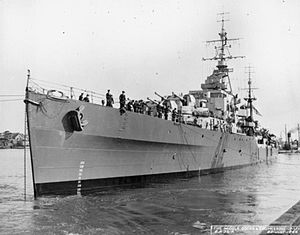
HMAS Napier (G97/D13) was an N-class destroyer serving in the Royal Australian Navy (RAN) during World War II. Built during 1939 and 1940, the destroyer was commissioned into the RAN, although she was ordered and owned by the British government. During 1941, Napier operated in the Mediterranean, before being transferred to the British Eastern Fleet at the start of 1942, then to south Atlantic operations in early 1944. In 1945, Napier was assigned to the British Pacific Fleet, and spent the rest of World War II in the fight against Japan. After the war's end, the destroyer was decommissioned and returned to the British. She was sold off in 1955, and broken up in 1956.

HMAS Nepal (G25/D14) was an N-class destroyer of the Royal Australian Navy (RAN). Launched in 1941 as Norseman, the ship suffered significant damage during an air raid on the John I. Thornycroft and Company shipyard, and during repairs was renamed to recognise Nepal's contribution to the British war effort. Although commissioned into the RAN in 1942, the ship remained the property of the Royal Navy.

HMAS Nizam (G38/D15) was an N-class destroyer of the Royal Australian Navy (RAN). The destroyer, named after Osman Ali Khan, the last Nizam of Hyderabad, was commissioned into the RAN in 1940, although the ship remained the property of the Royal Navy for her entire career.

The Dido class consisted of sixteen light cruisers built for the Royal Navy during World War II. The first group of three ships were commissioned in 1940, the second group and third group were commissioned between 1941 and 1942. A fourth group, also described as the Improved Dido, or the Bellona class, were commissioned between 1943 and 1944. Most members of the class were given names drawn from classical history and legend. The groups differed in armament, and, for the Bellona's, in function. The Dido class were designed as small trade protection cruisers, and were designed with five turrets, each with twin 5.25 guns in high angle mountings, far more modern in design than previous light cruiser turrets, and offering efficient loading up to 90 degrees elevation to give some dual-purpose capability. While some damage was experienced initially in extreme North Atlantic conditions, modified handling avoided the problem. The fitting of the three turrets forward in A, B and C position depended on some use of aluminium in the structure and the lack of aluminium after Dunkirk was one of the reasons for only four turrets being fitted to the first group of three, while the third group had four turrets with twin 4.5 guns. The Bellona's were designed from the outset with four turrets, but with radar-guided guns, and carried an increased light anti-aircraft armament.

HMS Euryalus was a Dido-class cruiser of the Royal Navy. She was laid down at Chatham Dockyard on 21 October 1937, launched on 6 June 1939, and commissioned 30 June 1941. Euryalus was the last cruiser built at the dockyard.
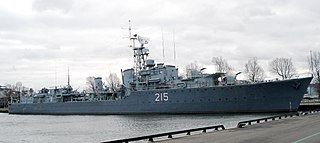
The Tribal class, or Afridi class, were a class of destroyers built for the Royal Navy, Royal Canadian Navy and Royal Australian Navy that saw service in World War II. Originally conceived during design studies for a light fleet cruiser, the Tribals evolved into fast, powerful destroyers, with greater emphasis on guns over torpedoes than previous destroyers, in response to new designs by Japan, Italy, and Germany. The Tribals were well admired by their crews and the public when they were in service due to their power, often becoming symbols of prestige while in service.
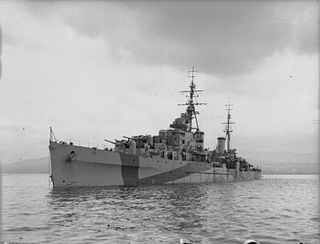
HMS Bellona was the name ship of her sub-class of light cruisers for the Royal Navy. She was the first of the fourth group of Dido-class cruisers. Built to a modified design with only four twin 5.25-inch turrets, but with remote power control for quicker elevation and training, combined with improved handling and storage of the ammunition. The light AA was improved over earlier Dido cruisers, with six twin 20mm Oerlikons and three quadruple 40mm "pom pom".

HMS Cleopatra was a Dido-class cruiser of the Royal Navy. She was built by R. and W. Hawthorn, Leslie and Company, Limited, with the keel being laid down on 5 January 1939. She was launched on 27 March 1940, and commissioned on 5 December 1941.

HMS Diadem was a Dido-class light cruiser of the Bellona subgroup of the Royal Navy. She was a modified Dido design with only four turrets but improved anti-aircraft armament – also known as Dido Group 2. She was built by Hawthorn Leslie and Company at Hebburn-on-Tyne, UK, with the keel being laid down on 15 December 1939. She was launched on 26 August 1942, and completed on 6 January 1944.

HMS Royalist was a Bellona-class light cruiser of the Royal Navy during the Second World War.

HMS Spartan was a Dido-class light cruiser of the Bellona subgroup of the Royal Navy. She was a modified Dido design with only four turrets but improved anti-aircraft armament - also known as Dido Group 2. She was built by Vickers-Armstrongs, with the keel being laid down on 21 December 1939. She was launched on 27 August 1942, commissioned on 12 July 1943 and completed on 10 August 1943.

HMS Rotherham was an R-class destroyer of the British Royal Navy during the Second World War, named after Captain Edward Rotheram, who commanded HMS Royal Sovereign during at the Battle of Trafalgar in 1805. Rotherham was completed in 1942 and equipped as a flotilla leader, having slightly reduced armament to allow for the increased complement and working space required. Decommissioned in 1945, the ship was sold to India in 1948, serving as INS Rajput (D141) until 1976, when she was scrapped.
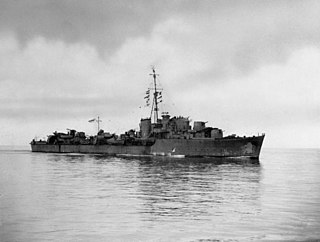
HMS Panther was a P-class destroyer built for the Royal Navy during the Second World War. After commissioning on 12 December 1941, she made a short trip to Iceland with the battleship King George V, then escorted a British convoy to India. In early April 1942, Panther rescued survivors from two cruisers sunk in the Indian Ocean, after which she took part in Operation Ironclad, the Allied invasion of Vichy French-held Madagascar, and sank a French submarine with another destroyer. Panther then returned to the Mediterranean, and participated in the Allied landings in North Africa, but was severely damaged in an air attack and had to undergo repairs in Gibraltar. After taking on survivors from the torpedoed SS Strathallan, Panther escorted two Allied convoys in the Atlantic. She next supported the Allied attack on Sicily, then sailed to the Aegean Sea in the Dodecanese Campaign. On 9 October 1943, Panther was sunk by German Stuka dive-bombers with 33 dead.

HMS Tartar was a Tribal-class destroyer of the Royal Navy that saw service in most of the naval theatres of World War II. She had an eventful career, eventually receiving the nickname 'Lucky Tartar' due to her numerous escapes from dangerous situations. She was one of only four from the sixteen Royal Navy-operated Tribal-class destroyers to survive the war.

HMS Roebuck was an R-class destroyer of the British Royal Navy that saw service during World War II. She was the fifteenth ship to carry this traditional ship name, after a small deer native to the British Isles, which was used as far back as the reign of Queen Elizabeth I.

HMS Carlisle was a C-class light cruiser of the Royal Navy, named after the English city of Carlisle. She was the name ship of the Carlisle group of the C-class of cruisers. Carlisle was credited with shooting down eleven Axis aircraft during the Second World War and was the top scoring anti-aircraft ship in the Royal Navy.
HMS Echo was an E-class destroyer of the British Royal Navy that saw service in the Atlantic, Arctic and Mediterranean theatres during World War II, before being transferred to the Royal Hellenic Navy in 1944, and renamed Navarinon, until scrapped in 1956.

HMS Meteor was a M-class destroyer built for the Royal Navy during World War II.

HMS Albrighton was a Type III Hunt-class destroyer built for the British Royal Navy. She entered service in February 1942, first carrying out an attack on German ships in the English Channel then taking part in the Dieppe Raid, rescuing survivors from the sinking destroyer HMS Broke. Albrighton was next assigned to search for and destroy the German auxiliary cruiser Komet, then escorted a convoy to Gibraltar in prevision of the Allied landings in North Africa. Between December 1942 and April 1943, she participated in the sinking of three more Axis ships with the First Destroyer Flotilla. During the Normandy Landings in June 1944, Albrighton served as a headquarters ship, then sank two German trawlers in the weeks after the invasion. After being converted to a destroyer in early 1945, she was damaged in a collision with a Landing Ship, then was assigned to the British Eastern Fleet. However, the war ended before she was deployed and Albrighton went into reserve.
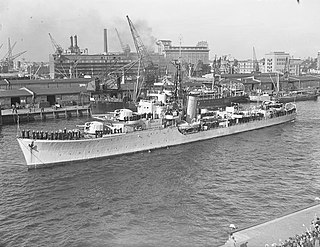
The destroyer HNLMS Tjerk Hiddes was a British built, Dutch warship of World War II. She was laid down on 22 May 1940 as a British N-class destroyer and launched on 25 June 1941 as HMS Nonpareil, but on 27 May 1942, she was transferred to the Royal Dutch Navy. The ship was commissioned in 1942 as HNLMS Tjerk Hiddes, named after the 17th century Dutch admiral, Tjerk Hiddes de Vries. Much of her war service was with the Royal Navy and United States Navy in the Indian Ocean and Australia. Following the war, the destroyer was sold to Indonesia and renamed RI Gadjah Mada. She was scrapped in 1961.
